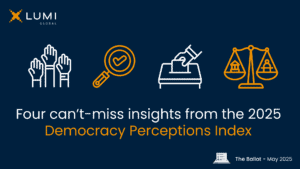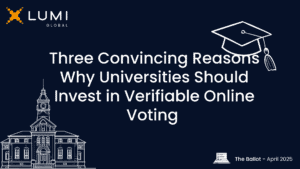Earlier this year, the American National Institute of Standards and Technology (NIST) published a study which interviewed leading election and cybersecurity experts about the introduction and future of end-to-end verifiable (E2E-V) voting systems. In this edition of The Ballot, we set out to both examine and address these experts’ concerns while also laying the groundwork for further research on the human impact of E2E-V voting.
Concern #1: E2E-V Makes Voting More Complex
It’s no secret: the exact cryptography and mathematics which go into making a fully E2E-V online voting system are difficult to comprehend for many of us. Resultingly, several experts interviewed in the study expressed concerns that introducing E2E-V could add a “layer of complexity” to elections which can spell trouble for those participating in or running them.
That being said, the best approach to evaluate E2E-V voting is not by what it might do, but what it actually does. The goal of systems like Electa is to bring the physical polling station into the digital realm by means of making elections fully transparent, distributing responsibilities to multiple administrators, ensuring voter anonymity, and enabling all involved in the election to confirm that any generated results are correct.
Despite the advanced technology underpinning it, what E2E-V provides – namely supporting fundamental democratic principles in online elections– is something which anyone can understand and appreciate.
Concern #2: It’s Hard to Tell What Problem(s) E2E-V Addresses
So, if E2E-V is such a big deal (which it is!), it must solve some major issues with online voting, right? Well, some experts are uncertain, with one stating that it just “makes computer scientists feel better” and another skeptical that it solves concerns voters themselves have about elections.
If you’ve seen our recent webinars, one term we emphasized was “tamper evident.” The concept is simple, yet oh so critical: if something goes wrong during an election, it should be immediately detectable. This is made possible by the system recording all activities taking place within it before, during, and after an election as part of enabling full transparency.
We hope it’s obvious at this point, but an election – physical or digital – is not trustworthy if it isn’t transparent. The transparency E2E-V provides is therefore much more about maintaining trust than pleasing computer scientists. And, without trust, no organization or government can hope to have smooth-running elections!
Concern #3: Explaining E2E-V to Voters, and Gaining Their Trust, Is Difficult
You can’t have elections without voters, and it is therefore highly important that voting technology is developed and deployed with them in mind. Though several experts express their hope that E2E-V voting systems can do wonders for making voting more accessible, some argue that voters “don’t care” about E2E-V and that “you can’t create voter confidence with math.”
To address this, a great place to start is a quote from one expert interviewed in the study:
“How many times have you gotten on an airplane? And did you understand what it takes to make an airplane safe? And, of course, very few of us do…Well, so why did you do it? Well, you had experts that you believed in, or friends that believed in experts, or experience over time.”
“Experience over time” is bolded here for a reason: the most trusted technologies are those which are thoroughly tested, deployed, and consistently improved over time. We don’t trust airplanes because scientists and airlines tell us to; we trust them because they have been widely vetted and used for decades. Computer scientists have come to a consensus that E2E-V is necessary for secure online elections, but there is still an urgent need to get voters on board with testing and using the technology.
In other words, the problem with voters’ skepticism towards E2E-V voting is not the technology itself, but rather that it has not been utilized widely enough for voters to understand and trust it. It is our hope that, as we work towards standards for online voting systems, we can progress further in familiarizing voters everywhere with E2E-V voting.
This article was originally posted as the June edition of Lumi Denmark’s monthly LinkedIn newsletter, The Ballot. To see older editions, subscribe, and stay up to date with what we’re up to, head to the homepage of The Ballot on LinkedIn here.


